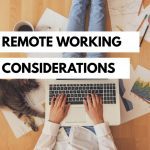As the dust settles on a very challenging year, the promise of a new way of working glistens in the dirt. Upon a closer look, isn’t it the same remote working we’ve always known? Jon Abbott relearns the lessons of remote work and suggests all you need to make it work is scale!
We will remember 2020 as a tumultuous year. Everything from the way we work to the way we socialize has been uprooted and reimagined. It stands in sharp contrast to the gradual, slow, piecemeal change that usually accompanies our steady evolution. This sharp shock to the system has engineered new possibilities, opportunities, and, as ever, new challenges.
But, for the workplace, perhaps all of this was bubbling up for some time. We’ve repeatedly heard of Millennials pushing for new working patterns, resisting meaningless working models, and introducing modern perspectives into the workplace. And, now, Millennials make up 35% of the workforce!
Diversity has been a topic on the top table for some time. Still, the pandemic has amplified existing inequalities for diverse employees and pushed diversity right to the top of the agenda again. Diverse workers tend to have more vulnerable jobs that are subject to furlough or layoffs. Pressure has been building on organizations to confront inequality in their workforces now more than ever.
Technological transition and the tools available for rapid, mass, and nimble video communication to entire workforces, teams, and individuals have been accessible for some time. How is it that so much of this technology is unavailable, incompatible, or doesn’t fulfill our needs as workers or individuals? Why does it still present a challenge to our teams, and why does it not meet our emotional and psychological needs even when video communication allows us to speak and empathize with our teams?
The 4 Big Challenges of Remote Work
Remote work has been thrust upon us by a rapidly changing world. As we look to the future for stability, why aren’t we seeing companies planning to return to pre-COVID normality? In many cases, the employees and the management like the flexibility that remote working offers – the chance to see more of the family or to spend less time stressed out in the commute. There are significant productivity benefits. However, it’s also true that there are some notable challenges as well.
Health
For as long as I have worked in ergonomics, there have been genuine health challenges associated with home working. It requires equipment, training, and planning. In the past, a small number of workers, usually in the employee base’s upper tiers, were set up through internal processes with access to space and a working environment they can call their own.
The pandemic put an end to that. Many workers did not have the space, equipment, or understanding of the ergonomics and health risk factors. Companies across the globe quickly adapted their processes to meet this need and help employees, if not overcome, at least mitigate many of these risks. It was a huge challenge, and they rose to it.
I should mention that there are mental health risks too. I won’t detail the depression, anxiety, or stress produced from the pandemic and home working. It’s worth stating that post-pandemic remote working will need to take many of the learnings from this period to ensure a healthy working environment.
Processes for continued homeworker should be in place. There should be a renewed focus on risk assessment and understanding each employee’s risks from their working environment. Suitable training should be issued and a process for deploying equipment and technology that can reduce risk, but only after an appropriate risk assessment.
Communication Technology
We’re all now familiar with the gripes of Zoom fatigue, of scrabbling around for the right communication platforms, and of incompatible software. In a pre-COVID study, 92% said that video collaboration technology “helps improve relationships and fosters better teamwork.” After a year of frequent use, I wonder who would say the same now?
Of course, video communication technology is not going away. It is a fantastic tool to bring people together; that’s a given. Organizations need to provide a mix of collaboration and communications technology beyond video and instant messenger platforms. It will ensure that these limited applications aren’t stretched to a breaking point, which can be frustrating for users. Think about how project planning, message boards, collaborative whiteboards and mind maps, shared spreadsheets, word processors, and presentation platforms can link with existing communication platforms to reduce the pain and mental strain of trying to do it all with video platforms.
And there’s the feeling of loneliness, detachment, and strange anomie that arises from video communication. It’s undoubtedly the distance that causes it, through an assortment of missing non-verbal cues and behavioral nods, the inability to share a private joke within the crowded faces, the stress of watching yourself perform on camera, and the worries of technical glitches.
To reduce that weariness and fatigue, the organization has to weigh up the positives and negatives of video communications. It’s not a panacea but used in conjunction with email, phone, IM, message threads, and collaborative tools. It can help bridge the gap and keep everyone connected.
Contractual
Outline clearly and consistently the options that workers have and make it a given rather than an exception. Traditionally, the remote working employee has often been senior, experienced, and decided upon a permission-basis.
In 2021, many organizations will likely move towards a flexible working environment, setting the expectation that people will have access to the systems and equipment they need. To ensure your teams know their job expectations, you may need to change your workers’ contractual basis.
You will need to consider:
- When should employees head into the office, and when should they stay at home
- The type of work expected from each working environment – i.e. creative, collaborative, project work, email communication, etc.
- How to support workers in each environment in terms of technology and equipment, and what each worker will receive
- Travel and commuting arrangements and expenses
By making it a “given,” workers will know the expectations, how and where to ask for help, and remove any ambiguity over the arrangements.
Management and Work Relations
The world has changed, and so too our organizations have changed. The way upper management has dealt with the pandemic has been focused on supporting workers and the way they work and through a culture of care.
There is no way back for most organizations. Command and control management has been swept away by the change and replaced by the supportive, nurturing model commonly associated with remote work.
This change brings with it many managerial challenges. In a post-COVID future, where flexible working is the norm, creating a deep-rooted culture that extends from office to home, giving good employee experiences that support health, enabling rapid communication, and providing what they need to get the job done is a must.
It needs a flip from time-in-the-office performance measurements to outcome-based performance measures, but that requires a supportive and skilled management team as well. Shifting the focus means everyone can be held accountable for their performance in a flexible environment.
Lastly, it means bringing together three key areas: the working environment, individual resilience, and your teams’ personality. Management needs to plan, understand the work environment of home users, provide training or support to build resilience, and assess personality types to be aware of how people work and how people perform.
Relearning what we already know
The big question remains, how do we approach the scale of the challenge and create a truly flexible workforce that empowers our people, enables creativity, and tackles the issues present in 2021 and beyond?
The issue now will be to relearn what we already know and implement those changes. Look to capture data and insight into how our different and disparate teams currently work and map out how they will need to change to a flexible working model.
Here are a few steps to help get you on your way:
- Get insight from your current working arrangements. Understand the needs of each segment of your working population
- Create flexible working options for different segments of your workforce. This option needs to be appropriate to their work, their needs, and their working environments
- Look for flexible working champions among your leadership who can espouse the values of flexible working for their segment
- Ensure that you communicate each option clearly, listing the benefits and risks
- Help employees understand and navigate the skills and training required for each flexible working model and the expectations
- Management and flexible working champions will need to train too. They’ll need cultural and leadership training to adopt new working models
- If you previously had flexible workers, utilize their knowledge and skills to pair with new flexible workers
- Communicate success stories to help embed change. A useful communication model for this is Kotter’s 8-step model for organizational change
The big challenge for you all is to ensure that you can enact change on scale. It will need some clear-thinking, and there will be huge issues to address, but understanding that we have been here before (albeit to a smaller segment of our workforce) will give you peace of mind when making your plans.






